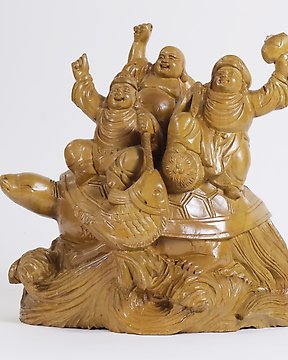
Charming Trio of Fortune: Hotei, Daikokuten, and Ebisu on a Turtle - 雕塑 木 - 日本 (没有保留价)
编号 83321475

编号 83321475

This is a lion head ornament created by Eijin Morise. There is an author's stamp on the back.
Eijin Morise is a woodcarving artist from Toyama City, who has participated in exhibitions such as the Japan Fine Arts Exhibition and the Japan New Craft Exhibition. Currently, he is active in solo exhibitions and group exhibitions. His works include hina dolls, Daikoku-sama, and lion heads.
The lion's head used in lion dances featured in Shinto Kagura and traditional festivals in Japan is recognized as a Buddhist art piece. It is an integral part of Japanese culture and heritage. The lion, appearing on stage, is perceived as a guardian deity that wards off evil spirits and disasters while bringing good fortune and prosperity. In some regions, the lion dance is performed to pray for a bountiful harvest, expressing joy and gratitude.
Being bitten by the lion's head is considered auspicious, and the reason lies in the wordplay between "噛みつくkamitsuku" (to bite) and "神付くkamitsuku" (to be blessed by a deity). When the lion bites someone's head, it is believed that the person becomes divinely blessed. There is a custom where, during the New Year, having the lion bite brings the belief that the person will experience a peaceful and safe year ahead, as they are blessed by the gods.
Shishi-Mai 獅子舞:
The familiar lion dance in Japan is often seen on New Year's and other auspicious occasions. The lion dance became popular during the Edo period with the practice of making a pilgrimage to Ise Jingu, known as "O-Ise-Mairi." For the people of old Japan, a journey to Ise was a cherished aspiration, something they wished to accomplish at least once in a lifetime. In an era when transportation networks were not as developed as today, the performing arts group called "Ise Daikagura" played a significant role, touring various regions and distributing amulets from Ise Jingu. It is said that the lion dance, performed to obtain benefits equivalent to the pilgrimage to Ise, became known in local areas and eventually grew into the nationwide folk entertainment we know today.
Culture of Shishi-Mai 獅子舞 Biting Heads:
In lion dance performances, there is a scene where the lion bites its own head. This action is believed to have originated from the meanings of "warding off evil (disease), eating" and "being possessed by a god (biting)." It is thought that this symbolic act contributes to the auspiciousness associated with the lion dance.
History of Shishi-Mai 獅子舞:
The Shishi-Mai 獅子舞 is a traditional performing art that has been passed down in Japan for centuries. More than 1400 years ago, during the reign of Emperor Suiko in 612 AD, the oldest existing chronicle, the "Nihon Shoki," recorded the roots of the lion dance as a form of performing arts called Kagura. It began as a masked dance rooted in Buddhism, performed to purify the surroundings. Prince Shotoku, a famous figure in Japanese history, actively promoted the spread of Kagura, incorporating it into temples in Nara, such as Todai-ji. This laid the foundation for the widespread practice of Shishi-Mai 獅子舞 in Japan.
Width:37.5 cm
Depth:25.5 cm
Height: 25.3 cm
Weight:700g
Condition:
Overall condition is good. But as you can see from the back, one of the horizontally crossed pieces of wood is detached. Additionally, there is a slight chip. There are signs of use due to age, such as dullness, scratches, fading, and dirt. It was kept at home for a long time. Please take a look as I have posted many photos.
Atention:
The items listed for sale are all used collectibles. Please consider them to have signs of aging, such as stains, scratches, scuffs, tears, discoloration, fading, fraying, and changes in thread color. We will post as many photos as possible to make it easy to understand. As these are old items, we appreciate your understanding before making a purchase.
Shipping:
The lot will be carefully packaged and shipped from Japan.
We will use either DHL or FedEx for a safe and secure transportation. It usually takes about 2-3 weeks for delivery, and the package will be shipped with a tracking number.
Import duties, taxes, VAT, and any other charges are not included in the item price and shipping cost. Please check your country's import duties before bidding.
041922500424